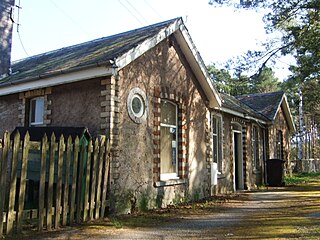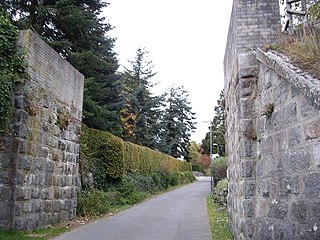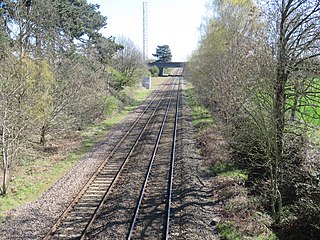
The Axholme Joint Railway was a committee created as a joint enterprise between the Lancashire and Yorkshire Railway (L&Y) and the North Eastern Railway (NER) and was established by the North Eastern Railway Act of 31 July 1902. It took over the Goole and Marshland Railway, running from Marshland Junction near Goole to Reedness Junction and Fockerby, and the Isle of Axholme Light Railway, running from Reedness Junction to Haxey Junction. Construction of the Goole and Marshland Railway had begun in 1898, and by the time of the takeover in early 1903, was virtually complete. The Isle of Axholme Light Railway was started in 1899, but only the section from Reedness Junction to Crowle was complete at the takeover. The northern section opened on 10 August 1903, and the line from Crowle to Haxey Junction opened for passengers on 2 January 1905.

Fenn's, Whixall and Bettisfield Mosses National Nature Reserve is a national nature reserve (NNR) which straddles the border between England and Wales, near Whixall and Ellesmere in Shropshire, England and Bettisfield in Wrexham County Borough, Wales. It comprises three peat bogs, Bettisfield Moss, Fenn's Moss and Whixall Moss. With Wem Moss and Cadney Moss, they are collectively a Site of Special Scientific Interest called The Fenn's, Whixall, Bettisfield, Wem & Cadney Moss Complex and form Britain's third-largest lowland raised bog, covering 2,388 acres (966 ha). The reserve is part of the Midland Meres and Mosses, an Important Plant Area which was declared a Wetland of International Importance under the Ramsar Convention in 1997. It is also a European Special Area of Conservation.

Warrington Central is one of three main railway stations serving the town of Warrington in Cheshire, England. It is located on the southern route of the Liverpool to Manchester Lines, the former Cheshire Lines Committee route between Liverpool and Manchester; the station is situated approximately halfway between the two cities.

Yaxham is a railway station in the village of Yaxham in the English county of Norfolk. The station is served by heritage services operated by the Mid-Norfolk Railway and is the site of the Yaxham Light Railway.

The Stocksbridge Railway was a subsidiary of Samuel Fox and Company and linked the company's works at Stocksbridge, near Sheffield, South Yorkshire, England, with the main line of the Manchester, Sheffield and Lincolnshire Railway at Deepcar. As the size of Fox's steelworks expanded, better transport links were needed, and the railway was authorised by an Act of Parliament in 1874. It was completed in 1877, and remained an independent subsidiary until 1992, when it became part of the steelworks operation. When the Woodhead line was closed to the north of Deepcar, the line south to Sheffield was singled, and operates as a long siding.

The Devon and Somerset Railway (D&SR) was a cross-country line that connected Barnstaple in Devon, England, to the network of the Bristol and Exeter Railway (B&ER) near Taunton. It was opened in stages between 1871 and 1873 and closed in 1966. It served a mostly rural area although it carried some through services from east of Taunton to the seaside resort of Ilfracombe.

Adlestrop railway station was a railway station which served the village of Adlestrop in Gloucestershire, England, between 1853 and 1966. It was on what is now called the Cotswold Line. The station was immortalised in the poem "Adlestrop" by Edward Thomas after his train stopped there on 24 June 1914.

Reedness Junction railway station was a railway junction near Reedness, East Riding of Yorkshire, England on the Axholme Joint Railway. Immediately to the west of the station, the Fockerby Branch, which continued eastwards, turned off from the main line to Epworth, which curved to the south.

Stainland and Holywell Green railway station served the villages of Stainland and Holywell Green in West Yorkshire, England from 1875 until 1929. Goods services ended in 1959. It was situated in the eastern part of Holywell Green.
Sarsden Halt was an unstaffed railway station on the Banbury and Cheltenham Direct Railway.

Lechlade railway station served the small town of Lechlade in Gloucestershire, England. The station was on the Oxford, Witney and Fairford Railway, between Oxford and Fairford, it was built where the line crossed the road to Burford, 0.5 miles (0.8 km) north of Lechlade.

Helmdon Village railway station on the Stratford-upon-Avon and Midland Junction Railway (SMJ) served the Northamptonshire village of Helmdon between 1872 and 1951. It was one of two stations serving the lightly populated rural area, the other being Helmdon railway station on the Great Central Main Line, and its closure marked the beginning of the years of decline for the SMJ line.

The Mound railway station was a former railway station on the Far North Line near the head of Loch Fleet in Scotland. For more than half of its life it was the junction for Dornoch.

The Coley branch line (ELR:COY), also known as the Coley goods branch, was a single-track branch railway running 1 mile 61 chains from the Reading to Basingstoke line at Coley Branch Junction to Reading Central goods depot.
The Hull and Doncaster Branch is a secondary main railway line in England, connecting Kingston upon Hull to South Yorkshire and beyond via a branch from the Selby Line near Gilberdyke to a connection to the Doncaster–Barnetby line at a junction near Thorne 8 miles north-east of Doncaster.

Bettisfield railway station was a station in Bettisfield, Wrexham, Wales. The station was opened on 4 May 1863 and closed on 18 January 1965.

Dinnet railway station was opened on 17 October 1866 by the Aboyne and Braemar Railway and served Dinnet village from 1899 to 1966 as an intermediate station on the Deeside Railway that ran from Aberdeen (Joint) to Ballater. Dinnet is located close to the River Dee in the parish of Glenmuick, Tullich And Glengairn, Aberdeenshire, Scotland.

Torphins railway station served the village of Torphins from 1859 to 1966 on the Deeside Railway that ran from Aberdeen (Joint) to Ballater.

Ōwhango was a station on the North Island Main Trunk line, in the Ruapehu District of New Zealand. It served the village of Ōwhango, which lay to the north of the station. It was 5.64 km (3.50 mi) north of Oio and 9.11 km (5.66 mi) south of Kakahi. The Public Works Department transferred the station to NZ Railways on 9 November 1908, though bush had been felled along the railway route in 1904, by March 1905 a station yard was being formed and by August 1905 it was the railhead, with track laid 4 mi (6.4 km) beyond to the south.

Checker House railway station was a station between Retford and Worksop, Nottinghamshire, England which served the village of Ranby from 1852 to 1931. The platforms were immediately to the east of the A1 road, and there was a goods station to the west of the road, which remained open until 1963. The line remains open for services on the Sheffield–Lincoln line but nothing remains of the passenger station or platforms, although part of a loading gauge was still visible in 2021.


















